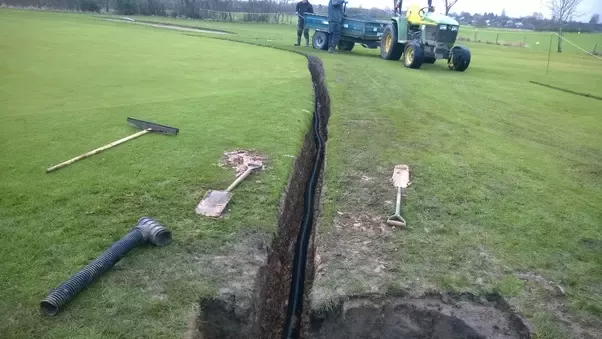Drainage issues can have a big impact on your yard and home. Standing water not only causes damage to grass, it can also lead to foundation problems and other interior damage.
Fortunately, there are ways to solve these problems before they get out of control. Here are some of the top 5 drainage solutions: 1. French Drains.
1. Gutters
The most basic step for home drainage problems is to get the gutters in order. If rainwater isn’t diverted away from the house, it will pool around the foundation and soak into the clay soil – which can cause damage over time.
Gutters can also get clogged with leaves, twigs, pine needles, dirt, seeds and other debris if they are not cleaned regularly. When clogged, it’s a short step from accumulating water in gutters to leaks and mold.
Downspout extensions help redirect the flow of water where it is needed, such as away from the foundation of the house. These are available in a variety of sizes and materials, including a stainless steel option. RELN splash blocks are also available that sit directly under downspouts and control the flow of water, preventing splashes that can cause mold.
Good yard grading can also help to direct water where it is needed. It takes time and money to do but it can make a big difference in how well your home and garden drain.
2. Trench Drains
Drainage problems aren’t always as easy to handle as they seem at first glance. In fact, a lot goes into making a drainage system that’s not only effective, but also safe and secure from the elements.
You’ll find trench drains in many places, like commercial parking lots and airports, as well as residential areas where they help with things like driveways. These drains use a trench of varying depth and length, a pipe to carry water away from the area, and a gravel backfill to prevent soil from clogging the pipe.
It’s not uncommon to see these types of drains with anti-theft locking devices, especially if they’re in public spaces where thieves can be a problem. They’re also commonly found at restaurants and breweries where they’re used to handle large amounts of liquid waste. Trench drains are usually made onsite using portable molds and tethering devices, so they’re more cost-effective to install than those that are prefabricated in a factory setting. However, this can increase installation time as engineers need to ensure that the drain is properly positioned and aligned.
3. French Drains
In the right situation, French drains are one of the best ways to get water out of your yard and away from your home. By redirecting water to a drainage area, they prevent moisture build-up in lawns and crawlspaces and can even keep basements dry. Coupled with soil gradation and gutters, they can also prevent moisture problems inside your house.
They work by creating a sunken channel to carry water away from your foundation, based on the principle that liquid always seeks out the lowest point along the easiest path. The pipe in a French drain is slotted or perforated at regular intervals to allow for easy flow.
After the pipe is in place, landscaping fabric is wrapped around it to keep weeds and dirt from blocking the holes. Gravel is then used to fill the trench to grade. If you have a municipal storm drain on your property, you can link it up to your French drain and send the excess water into the city sewer system. This is an essential drainage security measure for homes in areas that experience frequent heavy rain.
4. Septic Systems
Many homeowners live outside city sewer systems and use septic systems to treat wastewater. They cut pollution, odor, and disease by breaking down waste with natural and technological processes. They consist of a septic tank where solids settle and an absorption field or drainfield where the wastewater is further treated by soil.
Septic systems can become clogged or overloaded with too many toilets, sinks, or showers. They can also experience system leaks or failures. If you have slow-flushing or septic system backup issues, it’s important to address them right away.
Conventional septic systems utilize a distribution box to evenly distribute the wastewater from the septic tank into the soil drainfield (also called a leach field). This process is typically aided by oxygen-loving bacteria in the soil. If your soil conditions aren’t ideal for a conventional system, a pressurized septic system is an alternative. It uses a pump to distribute effluent into the drainfield, making it ideal for challenging site and soil conditions.
5. Storm Drains
Drainage problems can be frustrating and dangerous for your home. They often occur without warning and can cause flooding, foul odors or even leaks. Fortunately, there are solutions for your problem!
A storm drain (or surface water drainage system), also known as a catch basin, drains untreated rainwater from streets and other impervious surfaces. During a rainstorm, the water runs off buildings and paved areas, picking up trash and pollutants along the way. The storm drain carries it straight to local creeks, rivers, lakes and reservoirs.
Clogged storm drains are a common issue in towns and cities with large amounts of rainwater. Paper trash, twigs, leaves, grass clippings and other debris can wash into the drain and block it. If you live near a storm drain, help keep it clean by cleaning up any trash in the street or volunteering to clean up nearby drains.
For those that aren’t incredibly concerned about aesthetics, a channel drain is a great option for stormwater drainage. They consist of a concrete-lined, downward-sloping channel that whisks water away from where you don’t want it to be. It can be connected to a gutter downpipe, the local storm drain or your own specially designed pit.

